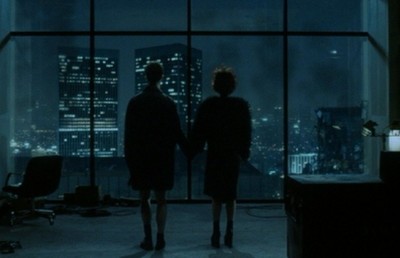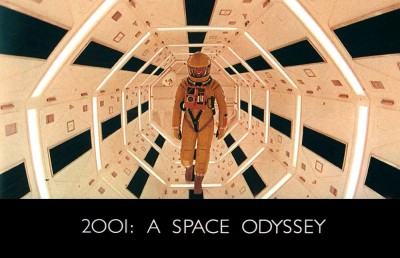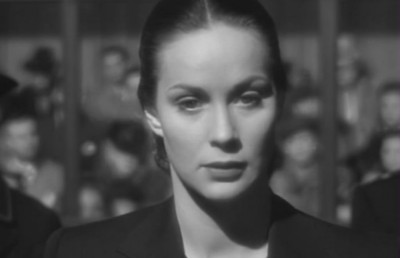Beneath the Surface of Things: Interpretation and Far From Heaven
Understanding Meaning

In film criticism meaning is a term that is difficult to pin down; when, for example, does something stop simply “being” and start “meaning”? What processes are necessary for this transformation to take place? Questions such as these inevitably lead us to an assessment of the role of interpretation, which –again– is a word with a slippery definition. At the centre of my concerns, around which I will construct my discussion, is Todd Haynes’ Far From Heaven (2002), a film with a unique position regarding interpretative criticism, as it is itself an “interpretation” of the work of Douglas Sirk, a director whose work has been subject to much changing interpretative study over the course of the development of film studies as a discipline.
David Bordwell, in his seminal indictment of interpretive film criticism Making Meaning, says “Knowing how to make movies mean is the principle source of such authority as film scholars possess, and there is little doubt that text-centred film study could not have entered the university without establishing its credentials as a hermeneutic discipline” (Bordwell, 1989, 256). He is almost certainly correct: finding meaning in a work of art via a process of interpretation has long been a grounding concept of the academic study of the arts as a whole, and it was unlikely that a critical discourse of film would develop in any wildly different way. For better or worse, we have seen that discovering meaning in a text automatically assigns to it a certain cultural value; in the case of film studies, it means that a film ceases to be “simply” entertainment and becomes, instead, art –and therefore worthy of critical attention.
The positioning of meaning at the centre of academic discussion of the arts was what prompted Susan Sontag to write her collection of essays, Against Interpretation and Other Essays, claiming interpretation to be “the revenge of the intellect upon art” (Sontag, 1977, 12). Sontag objects to the fact that, as she sees it, interpretation seeks to change a text into something it is not:
Directed to art, interpretation means plucking a set of elements (the X, the Y, the Z, and so forth) from the whole work. The task of interpretation is virtually one of translation. The interpreter says, Look, don’t you see that X is really – or, really means – A? That Y is really B? That Z is really C?” (Sontag, 14)
Such clinical “translation” is directly opposed to Sontag’s philosophy that criticism should be an “erotics of art” (Sontag, 22) that should analyse a work instead to “show how it is what it is –even that it is what it is– rather than to show what it means” through a focus on form and style. In Sontag’s ideal world, the work of art itself would be constructed so as to deny the very possibility of interpretation by being “just what it is” (Sontag, 21) . This, she says, is particularly achievable in cinema:
Is this possible now? It does happen in films, I believe… In good films, there is always a directness that entirely frees us from the itch to interpret… The fact that films have not been overrun by interpreters is in part due simply to the newness of cinema as an art. It also owes to the happy accident that films for such a long time were just movies; in other words, that they were understood to be part of mass, as opposed to high, culture. (Sontag, 28)
Whether cinema has managed to shift itself from mass to high culture is an impossible question to answer –and certainly not one that it is necessary to delve into here– but whatever the case, the fact is that since Sontag wrote Against Interpretation (1965) critics of film have certainly succumbed to “the itch to interpret”. As film has moved out of the cinema and into the university, acquiring value as an art form along the way, the critical discourse of its academic study has come to incorporate the same interpretive methods Sontag denounced. In response to this, David Bordwell, a copy of Against Interpretation proudly in hand, set out in 1989 many of the same arguments as Sontag, but applied exclusively to film studies, in Making Meaning.
Bordwell agrees that interpretation is a process of translation (“To interpret a film is to ascribe implicit or symptomatic meanings to it.” [Bordwell, 249]) and that more attention must be paid to style (“What may matter as much as implicit or repressed meanings is the surface of the work. [Bordwell, 264]”), but there is also an added stress here on the application of particularly invasive theories of semantics to a text. In fact, Bordwell’s definition of interpretation relies entirely on this aligning of interpretation with semantics: “The critic aims to present a novel and plausible interpretation. This task is accomplished by assigning one or more semantic fields to a film (Bordwell, 249)… style is chiefly a means to meaning: a window through which the critic watches characters embody semantic fields” (Bordwell, 260).
A problem with Bordwell’s (and, to an extent, Sontag’s) objection, however, lies in its own narrow interpretation of the word “interpretation”, as Victor Perkins says in his 1990 response “Must We Say What They Mean?”:
Bordwell’s account is absolutely bound to a view of the interpreting critic as a propounder of hidden meaning. It allows interpretation to bother itself only with meanings held to be ‘implicit’ or ‘symptomatic’, and these it opposes to whatever a film ‘directly states’…I suggest that a prime task of interpretation is to articulate in the medium of prose some aspects of what artists have made perfectly and precisely clear in the medium of film. (Perkins, 1990, 67)
In order to illustrate his own notion of what interpretation means (or can also mean), Perkins offers a brief analysis of twenty seconds of a scene from Max Ophuls’ Caught (1949). A description of a few tiny nuances of Barbara Bel Geddes’ performance of the character of Leonora (actions made with her hands and so forth, on which it is unnecessary to elaborate here) and the meanings they convey is enough to convince us –or remind us– that, yes, as viewers we are constantly interpreting in a manner that does not constitute translation. As Perkins says, following the analysis,
The camera cannot directly show what is in Leonora’s mind, but her aims and feelings are as much part of the narrative of Caught as the fact that she is sitting in a millionaire’s car. The meanings… are neither stated nor in any special sense implied. They are filmed. Whatever else that means… it means they are not hidden behind the movie. (Perkins, 67)
We see then in Bordwell’s and Perkins’ definitions two very different understandings of what it can mean to interpret a text. It is necessary to remain conscious of both notions of interpretation when considering Far From Heaven, and the films of the director whose work it draws from so liberally: Douglas Sirk. It will become obvious that an understanding of the position of Far From Heaven as regards interpretation must begin with an understanding of the critical reception of Sirk.
In her extensive study of Sirk’s films, Meaning and Melodrama: History, Culture and the Films of Douglas Sirk, Barbara Klinger uses historical analysis to show the changing ways in which Sirk’s films have been understood by audiences and critics over the years. As she says in her introduction, she attempts to explain the socio-historical reasons why the director’s films “have been historically characterised as subversive, adult, trash, classic, camp and vehicles of gender definition” (Klinger, 1992, 12). In the fifties, Klinger tells us, Sirk’s melodramas where described by the film industry as “adult” while critics called them “slick Hollywood illusionism” and “soap opera” (Klinger, 25). In the sixties and seventies Sirk was taken up by auteurists and Marxists as a progressive artist working within the Hollywood machine, his films interpreted as “transgressive of 50s bourgeois and patriarchal ideology” (Klinger, 59). In the late seventies, psychoanalytic readings uncovered a critique of the “unconscious sexual dynamics of patriarchal culture” (Klinger, 82) in the texts. The early eighties’ feminists praised the films’ power for “revealing the film industry’s gender machinations” (Klinger, 121), while the late eighties and early nineties saw a reappraisal of Sirk as the epitome of high camp, provoking both progressive and homophobic responses due to new knowledge of Rock Hudson’s homosexuality. The study posits potential reasons for these changing understandings of Sirk’s films, revealing, as Klinger says, “a dynamic historical process that transformed the significance, and value, of the works” (Klinger, 147).
Klinger’s work can in a sense be seen as an affirmation, of sorts, of Bordwell’s view by the fact that it illustrates very convincingly that texts in fact will always have fluid meanings, thus by implication suggesting that to assert one interpretation (using one ideological framework) as the only valuable reading of a film can therefore be seen –if viewed historically– to be a vain enterprise:
Aesthetic presumptions about textual worth are traditionally based on assertions that this meaning and no other is valid; and, further, we can prove this meaning by close analysis of a text’s internal organization and features. By contrast, historical analysis tells us that there is a certain fluidity to meaning, that textual characteristics are routinely subject to cultural rewriting, that there is nothing sacred about textual boundaries. (Klinger, 160)
Where then does this leave Perkins_’ concept of interpretation? It could be argued (as Bordwell does in his 1993 rebuttal in _Film Criticism, ‘Film Interpretation Revisited’) that it may peacefully co-exist with that of Making Meaning because the kind of reading Perkins describes is not interpretation as Bordwell defines it (i.e, “to ascribe implicit or symptomatic meanings” [1993, 249]). Perkins’ “_interpretation_” is simply Bordwell’s “_comprehension_” –a useful distinction. According to Bordwell: “comprehension is concerned with apparent, manifest or direct meanings, while interpretation is concerned with revealing hidden, non-obvious meanings” (1989, 37). Let us now then interrogate this distinction between “interpretation” and “comprehension” by applying the terms to Sirk.
All the interpreters unearthed in Klinger’s study, whether they be Marxists, feminists or psychoanalysts, are doing what Bordwell objects to: they are bringing their own ideological framework, their own semantic field, to Sirk’s films in order to establish meaning. It is what Making Meaning terms a “top-down” (Bordwell, 40) –as opposed to “bottom-up”– process, beginning outside rather than within the text. What though do we find if we analyse a Sirk film (let us take as our example All That Heaven Allows, 1955) using the “bottom up” –or “comprehension”– technique? Is it possible to find meaning this way too?
In All That Heaven Allows, the relationship that Carey pursues with her gardener, Ron, can unproblematically be seen as setting her apart from the community and ideology of Stoningham, the town in which she lives. The couple are treated as outsiders at social gatherings (shown most clearly in the Mona party scene) and Carey is eventually forced to make a clear choice between her bourgeois life as a social entity and the Transcendentalist lifestyle practised by Ron. Accordingly, Sirk uses film language to illustrate this division of lifestyles, and clearly shows cinematically that the freedom offered by the escape from the social set of Stoningham is more pleasurable than the repression that is necessary in order to remain within it. The interior of Carey’s comfortable middle class home, for example, is continually shot in cold colours and shrouded in shadow, her own children’s faces often hidden in darkness –whereas her moments of release from constrictive bourgeois life through Ron’s lifestyle, are filmed always in warm, vibrant colours. Set pieces such as the comparable party scenes (in which small, gossiping clusters of judgemental and sexually aggressive people typify the Stoningham crowd, compared with the happy, communal interaction between guests in Mick and Rick’s cabin), and sets (small, dark, angular spaces in Carey’s house as opposed to large, open, large-windowed rooms in Rick’s and Ron’s houses) also illustrate this distinction.
The opinion –if you like– of Sirk is clear: the ideology of the society life Carey was living is restrictive, suffocating and joyless, and the ideology of life with Ron (that she in fact chooses for herself at the film’s close), is free, exhilarating and joyous. As Laura Mulvey says in “Notes on Sirk and Melodrama”:
Ideological contradiction is the overt mainspring and specific content of melodrama, not a hidden unconscious thread to be picked up only by special critical processes…Carey’s world is divided into the cold, hard light (blues and yellows) of loneliness, repression and oppression and the warmer, softer light (red/orange) of hope, freedom and sexual satisfaction….It illustrates the basic division that the film is actually about. (Mulvey, 1977/78, 54)
It is certainly a film in which ideologies are set aside one another, and a judgement about the worth of each is made. This conclusion we can safely say we have reached by a process of “comprehension”: that is, by analysing the film’s style and “directly stated” content. The leap of interpretation comes at the moment at which the critic names this conclusion as the “meaning” of the film, and stakes a claim to the text for his or her own ideological beliefs. For a critic to say, “In All That Heaven Allows the character of Carey transgresses the bourgeois and patriarchal ideology of Stoningham,” is what Bordwell would call “comprehension.” 1 If, however, a Marxist critic was to say, “All That Heaven Allows is transgressive of 50s bourgeois and patriarchal ideology”, (s)he would be constructing, according to Bordwell’s schema, an interpretation. The leap is small, but one must see that it is a leap nonetheless.
We have seen then that, although the line between comprehension’s “apparent, manifest or direct meanings” and interpretation’s “hidden, non-obvious meanings” can certainly be more blurred than Bordwell would have us believe, the All That Heaven Allows example can finally do little to dispute his statement in “Film Interpretation Revisited” that says, “I understand that profilmic elements, like actors sitting in a hollow car mock-up, can be filmed, but I am at a loss to explain how meanings can be filmed” (1993, 256). As Sirk himself said of his own films: “What I’m doing is just showing things –the criticism must start with the audience.” (quoted by Haynes in ??Far From Heaven??’s DVD commentary).
Which brings us finally to Haynes’ film. I shall henceforth argue that Far From Heaven is a film that does manage to film meaning because it is itself a work of interpretation, a piece of cinematic film criticism if you will. In turn, as a film text itself, it can therefore be seen as not requiring interpretation, and in fact is, paradoxically, exactly the kind of art that Sontag so praises: that is, a work of art “whose address is so direct that the work can be . . . just what it is.”
Far From Heaven, as a film, clearly adores Sirk. It also plainly ascribes to the interpretation –held by virtually all his interpreters– of Sirk as a director who displays politically progressive notions; on Haynes’ DVD commentary, for example, there are many loving references to the “social critique” inherent in the films. The critique in Sirk is interpreted in Haynes in two main ways. Firstly, the issue of racism that is touched upon in the former’s work –made particularly clear as a theme in Imitation of Life (1959)– is pushed to the fore in Haynes’ film through the centrality of Cathy’s relationship with her black gardener Raymond and the uproar it causes in the community. This, as Jonathon Rosenbaum says in his review of the film, shows an assumption of a valuable social comment in the source material:
Part of the problem with updating Sirk to make room for a more comprehensive view of racial intolerance is that it idealizes the social impact of the original Sirk movies when they came out…I saw Imitation of Life, Sirk’s last feature, when it came out in 1959 in an all-white theatre in northwestern Alabama, surrounded by matrons sobbing over the death of the film’s conservative Aunt Jemima figure. I find it hard to believe that Sirk was slyly subverting racial stereotypes, because no one at the time seemed even remotely aware of the alleged subterfuge. (Rosenbaum, 2005, 1)
Whether or not the original films intended a social commentary or not is now in fact unimportant to my argument (the above is merely Rosenbaum’s own interpretation), what is important is that Far From Heaven –by making its own racial commentary more pronounced– clearly interprets them as doing so.
Secondly, an aspect of Far From Heaven that speaks even more clearly of the film’s role as an interpretation of Sirk is the presence of the character of Frank, Cathy’s closeted homosexual husband. In an interview with Dennis Quaid, Haynes is quoted as saying the following:
Sirk may well have been aware of the gay subtext of his own films, Haynes suggests, particularly ??All That Heaven Allows??… “Sirk made Rock Hudson a star at Universal in the ’50s,” Haynes says. “That adds another level to the film. It calls things into question.” (in Duralde, 2005)
Haynes is voicing a common “top down” interpretation of All That Heaven Allows (and one which has permeated to Hudson’s other films) that is based on new knowledge about Rock Hudson, who –to great public surprise– publicly came out as gay in 1985 after contracting the AIDS virus. The inclusion of an outwardly ‘man’s man’, but closeted gay, character in Far From Heaven can be seen, as Richard Falcon says in Sight and Sound, as “Haynes being frank about the fact that we can’t nowadays watch All That Heaven Allows or Written on the Wind (1956) without another subtext –closeted desire– being added through our relatively new knowledge of the sexuality of the films’ star, Rock Hudson” (Falcon, 2005, 1). Haynes has interpreted a closeted homosexual desire in Sirk and is displaying this interpretation on screen in the character of Frank, meaning the film itself stands as his interpretation. Therefore, one need not infer a commentary about racism (as with Imitation of Life) or read one form of repressed desire as another (as in All That Heaven Allows) because Haynes places these meanings directly on the screen in an already-interpreted form.
Critics writing on the film have, however, in turn attempted to interpret Far From Heaven just as if it was a text like, say, any Sirk film –as if it was necessary to approach it the same way. Here are two brief interpretive comments made of the film:
Just as Safe was a response to the AIDS crisis in which the term AIDS went unmentioned, Far From Heaven is a furious denunciation of the return to the rampant power of the military-industrial complex. (Amy Taubin, 2005, 1)
Against the increasingly symbolic landscape of Far From Heaven it’s hard not to see Raymond as something closer to a metaphorical Other than a real person.” (Andrew O’Hehir, 2005, 1)
The urge to interpret the film is understandable: apart from anything else, Haynes is, after all, a director who has his roots in the world of ‘independent’ art cinema, an area of filmmaking that is (speaking very broadly) associated with notions of the director as author and therefore with notions of interpretation. [It could be argued that interpretive film criticism was only made possible by the establishing of the auteur as a maker of meaning.]] Indeed –as Taubin says– his 1995 film Safe is a highly interpretable work which has clear potential for being read as a middle class satire, or a symbolic depiction of AIDS, or both. It follows then that Far From Heaven too would be approached with a view to interpreting it. In this case it is, however, unnecessary.
Because Far From Heaven is a progressive interpretation of Sirk, for a critic to construct a progressive reading of Far From Heaven is not an interpretation but merely comprehension. To do so is the equivalent of constructing a progressive reading of a piece of political film interpretation in the periodical CineAction!. This is not to say that Far From Heaven cannot be seen as having a contemporary political relevance, only that its contemporary relevance is inseparable from its interpretation of the relevance of Sirk, which we have already established as film’s project. In the same way as, for example, Robin Wood revisits and reinterprets the films of Ozu in order to make a political commentary on the present day, so is Far From Heaven politically engaged with the present.
In this way, Far From Heaven –although it itself practices interpretation– actually achieves the feat of being a work of art that is “just what it is”: precisely what Sontag calls for in Against Interpretation:
Ideally, it is possible to elude the interpreters… by making works of art whose surface is so unified and clean, whose momentum is so rapid, whose address is so direct that the work can be . . . just what it is. (Sontag, 22)
The “just what it is,” in the case of Far From Heaven, is that the film is “just” an interpretation. In Against Interpretation Sontag speaks polemically of “the illusion [perpetuated by interpretation] that there is such a thing as the content of a work of art” (Sontag, 18), by which she simply means that a consideration of content cannot be removed from a consideration of style, for they are ultimately inseparable. If we apply the return to a focus on form that Sontag longed for to Far From Heaven, we find everything we need to know about the film, because it is simply impossible to separate its style from what the film “directly states.” The precise recreation of Sirk’s colour palette, the expressive use of shadows, the melodramatic score, the occasionally sweeping crane shots, the costumes, the reliance on medium shots: everything honestly states that the film is “just what it is” –a filmed interpretation of Douglas Sirk. The difference between Far From Heaven??’s form and Sirk’s is that a Sirk film’s form comments on its content while ??Far From Heaven??’s form (because the whole film is a recreation) is its content. Put another way, whereas with ??All That Heaven Allows we found that “bottom-up” comprehension can bring us only to the themes –not the meaning_– of the film, in Far From Heaven the very filming of these same themes _is the meaning.
There seems, however, perhaps a rather large contradiction in what I have so far been claiming. All my talk of a “bottom-up” comprehension being all one needs in order to grasp the meaning of the film has, in fact, been based on an assumption of one very important piece of “top-down” information: a knowledge of Douglas Sirk. How can one comprehend the meaning of the film as an interpretation if one does not realise that anything is being interpreted? The fact is though that knowing that the film is an interpretation is not the point: the fact that it is simply means that it communicates directly and openly. Everything in the film is so much about surface, as I have been illustrating. It truly contains, as Sontag puts it, a “liberating, anti-symbolic quality” (Sontag, 17). Haynes, speaking in The Filmmaker’s Experience featurette on the DVD, says:
You know… there’s kind of no subtext. People ask me about that line, ‘“I wish we could get beneath the surface of things,” is that what your message is in this movie?’ And, in a way, it’s exactly the contrary. Everything in this film is on the surface; it’s almost like you go beneath, and then you come back to, the surface.”
The line he is speaking of is spoken by Raymond when Cathy tells him that she can’t bring herself to keep seeing him, and it stands as an apt representation of the way in which the film does not require interpretation as a whole. Firstly, we understand the words themselves as stating the obvious theme of Cathy and Raymond’s relationship (they are even followed by “[if only we could see beyond] the colour of things”) in a direct way. Haynes’ comment shows that people have then tried to interpret the line by suggesting it has a larger meaning for the film as a whole, when finally it simply is what it seems to be and means what it seems to mean: that the character of Raymond longs for racial equality. The ‘apparent’ surface truth is the whole truth.
This is the case for the film as a whole. Haynes says in his interview with Geoffrey O’Brien, “Everything about film is always artificial. You can come to something far more surprisingly real by acknowledging how much of a construct it is first.” (O’brien, 2005, 1). Far From Heaven ultimately moves us because it is a film that acknowledges, and exists on, its emotionally heightened surface. There is no need to go beneath the tear-jerking score, the hysterical acting style, the simple plot, for meaning or emotion: they are meaning and emotion. O’Brien writes:
There is here simply a vocabulary of apparently banal acts and gestures and objects that, properly deployed, can express what would otherwise be unsayable. You can regard it through whatever prisms of irony and complication you like, but the forms themselves remain the same: A glance is a glance, good-bye is good-bye. (O’Brien, 1)
Whether or not one knows of Sirk, Haynes’ interpretation of him places the emotions, meanings and forms of his films in a context which allows them to be felt and comprehended openly and directly. It could be argued in fact that to be unaware of the film being an interpretation is in fact the ideal situation for a viewer to be in, as it means that (s)he need not even stray from the surface of the text for a moment (as a viewer familiar with Sirk may do by questioning the reason for the reinterpretation), but instead may immediately and unquestioningly experience “the luminousness of the thing in itself, of things being what they are” (O’Brien, 23), as Sontag says one must.
It is telling that an investigation of interpretation and meaning has led me ultimately to a consideration of emotion. An emotional response such as I –and, it is probably fair to assume (based on the fact that this melodrama was a commercial as well as critical success) many others– experience on watching Far From Heaven cannot be reached by a “top down” process of interpretation: it is something that occurs naturally between the viewer and the work of art (right at the “bottom”, as it were). Analysis of a text can only lead one to a deeper understanding of how the work achieves its emotional impact. I believe that were it not for that first initial sharp shock of feeling I would not have undergone my analysis of the film in the first place. Perkins says in “Must We Say What They Mean?”:
The starting point for an inspection of the Caught fragment was a desire to figure out what it was in the moment that made me smile. The evidence of feeling demands an acknowledged place in the process of interpretation. (Perkins, 70)
“The evidence of feeling” is a useful concept. How valuable can a film really be if it does not make us feel? This is quite probably a question with as many different answers as there are viewers of film, but, for myself, I believe that communicating emotion is one of the very highest achievements a work of art can attain. Communicating a meaning is also a valuable aim, however I am inclined to feel that a meaning conveyed without emotion is a meaning lacking in a necessary power. How worthwhile is it to communicate a meaning which does not have the power to move us and, by moving us, change us?
Similarly, how valuable is an interpretation that does not have the power to move us with its meaning? Such an interpretation communicates its own ideology aridly and thus unconvincingly, and must therefore be rejected. As Perkins says (and, to an extent, Sontag, with her “erotics of art”): in criticism, as in art, there must be a space made for “the evidence of feeling.” Reading Far From Heaven as we have been, we may see it as a work of interpretive criticism which does exactly that.
Bibliography
Bordwell, D. Making Meaning: Inference and Rhetoric in the Interpretation of Cinema. Cambridge: Harvard University Press, 1989.
Bordwell, D. “Film Interpretation Revisited.” Film Criticism (Winter/Spring 1993): 93-119.
Klinger, B. Meaning & Melodrama: History, Culture and the Films of Douglas Sirk. Bloomington: Indiana University Press, 1994.
Mulvey, L. “Notes on Sirk and Melodrama.” Movie 25 (Winter 77/78): 53-6.
Perkins, V. F. “Must We say What They Mean?: Film Criticism and Interpretation.” Movie 34, 5 (Winter, 1990): 1-6.
Sontag, S. 1977. Against Interpretation and other Essays. New York: Dell, 1964.
Internet Citations
O’Hehir, A. Far From Heaven.
Falcon, R. Magnificent Obsession.
Murray, G. ‘Magnificent Repression.’
O’Brien, G. Past Perfect: Todd Haynes’ Far From Heaven
Duralde, A. Dennis Quaid Interview
Taubin, A. In Every Dream Home
Notes
- And Perkins would call “interpretation”: we have had to interpret what Carey’s individual acts “mean” ideologically, but have not ascribed this ideological “meaning” to the film as a whole. ↩













